
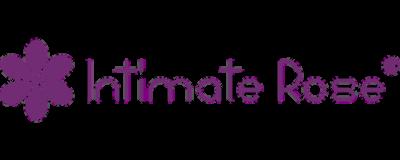

Tips. Exercises. Resources. Dr. Amanda Olson, DPT, PRPC President & Chief Clinical Officer PCOS & YOUR PELVIC FLOOR

Dear friend,
We’re so excited to be a small part of the Dr. Talks PCOS Summit, discussing a condition that affects so many people worldwide. It is important to find safe and friendly communities such as this one to connect with others to ask questions, get answers, and find hope.
My name is Amanda Olson, and I am a dedicated Doctor of Physical Therapy passionate about enhancing people’s health, particularly in pelvic floor disorders. Having entered the world of pelvic floor therapy because of my own personal experience, I'm proud to now lead as the President and Chief Clinical Officer at Intimate Rose. Our mission is to improve women's health globally, offering compassionate care and quality products.
If you're new to Intimate Rose, rest assured that your goals are our goals. We're here to support you not matter where you are on your own journey. Amanda
 Dr. Amanda Olson, DPT, PRPC President & Chief Clinical Officer
Intimate Rose
Dr. Amanda Olson, DPT, PRPC President & Chief Clinical Officer
Intimate Rose
2
Introduction
Polycystic Ovary Syndrome (PCOS) is a common hormonal disorder that affects as many as 1 in 10 women. While PCOS primarily impacts the reproductive system, it can also have significant effects on the pelvic floor. The tension and stress in this region caused by many of the symptoms from PCOS can result in chronic pelvic pain syndrome or issues within the pelvic floor muscles.
If left untreated, these pelvic floor conditions can eventually impact various other bodily systems, including muscles, bones, the digestive system, and reproductive health.
In this guide, we’ll explore the relationship between PCOS and pelvic floor health. We will also discuss treatment options and lifestyle changes that can help manage PCOS-related pelvic pain, with a focus on the benefits of pelvic floor physical therapy.
3
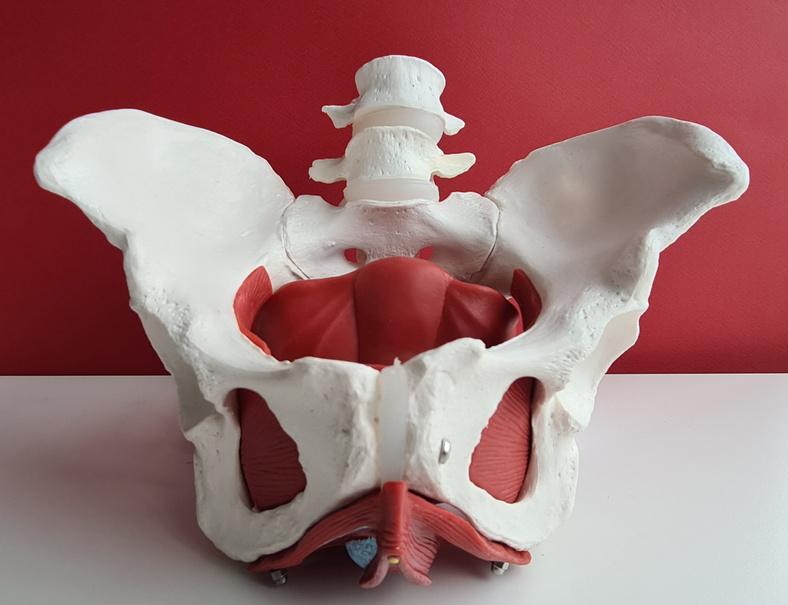
Your Pelvic Floor Muscles
The pelvic floor muscles, located at the bottom of the pelvis, are a group of muscles that support the pelvic organs. Their function includes regulating urination and bowel movements, and facilitating sexual activity. Similar to any other muscle group, they can encounter issues, such as:
Tension and spasms, leading to discomfort during bowel movements, sitting, vaginal penetration with use of tampons or during medical examinations.
Discomfort during intercourse including superficial and deeper penetration or orgasm.
Post-sex pelvic floor pain arising from overactive muscles.
Weakening of the pelvic floor due to factors like aging, childbirth, and more, which may result in unwanted leaks or vaginal prolapse.
Vaginal dryness or atrophy that happens from age, hormone changes, cancer treatment, and more. This can result in itching and discomfort, as well as painful intercourse.
4

PCOS and the Pelvic Floor
PCOS often brings with it a number of conditions that may have specific effects on the pelvic floor such as:
Hormonal Imbalance: Due to the drop in the level of estrogen produced by the body with PCOS, vaginal dryness may occur.
Endometriosis: PCOS can coincide with endometriosis, a condition where tissue similar to the uterine lining grows outside the uterus. This condition can provoke pelvic discomfort as it irritates the neighboring tissues.
Ovarian Cysts: Women with PCOS may develop ovarian cysts that contribute to discomfort. As these cysts grow, they exert pressure and create tension within the pelvic and abdominal region. Pelvic pain often intensifies during menstrual periods and sexual intercourse due to heightened pelvic pressure.
Uterine Fibroids: Uterine fibroids may also occur with PCOS. These benign growths can elevate pelvic pressure and tension, resulting in pelvic discomfort.
5
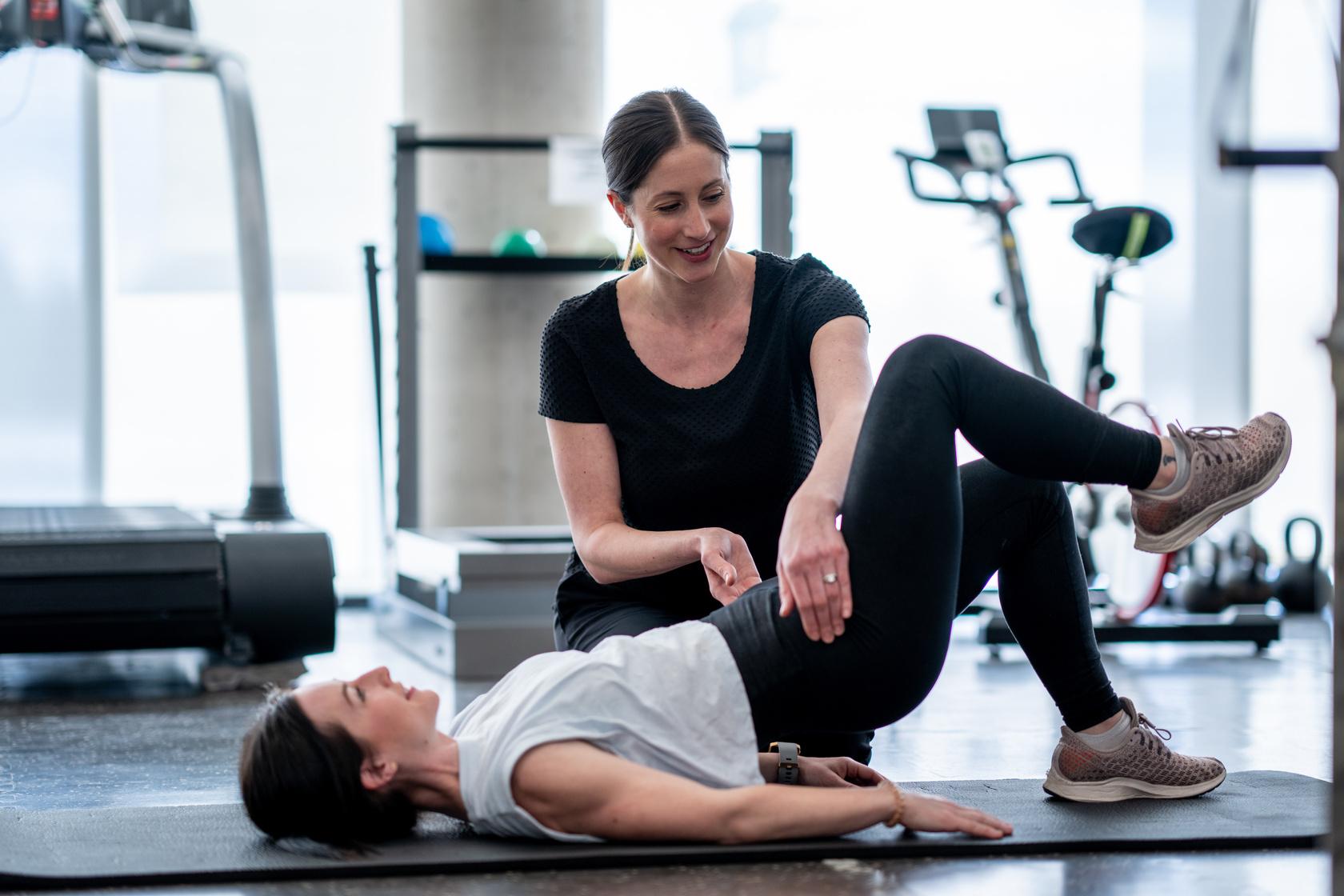
Pelvic Floor Physical Therapy (PT) and PCOS:
If you have been diagnosed with PCOS, it's a great idea to proactively seek out a pelvic floor physical therapist. Pelvic Floor Physical therapy is highly beneficial for individuals with PCOS to help address abdominal and pelvic pain, such as painful periods or painful sex. It offers the opportunity to look at simple lifestyle changes or recommendations for resources to aid relieving the pain.
A pelvic floor therapist can teach you how to appropriately relax and lengthen pelvic floor muscles, provide manual treatment techniques, aid in neuromuscular reeducation, and provide exercises to improve muscle function and reduce pain.
Some of the various solutions discussed during pelvic floor therapy may include:
6
Myo & D-Chiro Inositol
To help with overall hormone imbalance from PCOS that can lead to overall vaginal dryness, as well excess facial hair, acne, insulin resistance, infertility, anxiety and stress, Myo & D-Chiro Inositol may be a good option!
Inositol is a natural sugar found in foods like fruits, beans, nuts, and grains. Research has shown that it can offer many benefits to counter the above symptoms of PCOS.
The Intimate Rose 40:1 Myo and D-Chiro Inositol blend can help balance hormones responsible for producing androgens
(testosterone) so you feel fresh, clean, and clear. We’ve also added ashwagandha and Vitamin D for further support of PCOS symptoms including mood and stress!


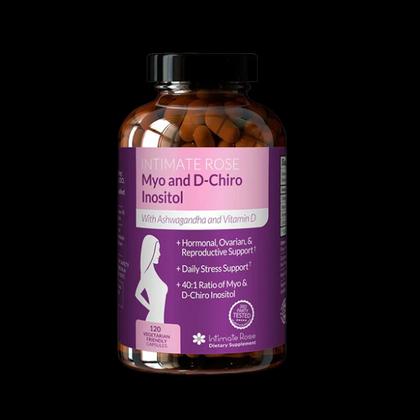
DR. TALKS EXCLUSIVE OFFER
Use code PCOSSUMMIT and receive 30% off your first bottle of Myo and D-Chiro Inositol you subscribe and save!

6 7
Cannot be combined with any other offer
Diaphragmatic Breathing
This exercise uses your body's natural breathing mechanics to gently stretch the pelvic floor muscles. Your abdominal cavity acts like a balloon when you breathe where the top of the balloon is the main muscle of breathing called your diaphragm, the bottom is your pelvic floor muscles, and the sides are your abdominal and back muscles.
When you breathe in, your diaphragm drops slightly into your abdominal cavity putting pressure on the top of your “abdominal balloon” which will provide a gentle stretch to the pelvic floor at the bottom of your abdominal cavity.
Some adults tend to restrict breathing into their chest cavity only limiting their ability to fully expand their lungs and relax the pelvic floor. To ensure good mechanics, place one had on your chest and one hand on your belly/abdomen when lying down.
When you breathe in, try to breathe into your belly and watch your belly hand move upward while your chest hand stays relatively still. When you breathe out, your belly hand will sink back to its initial starting position.
8
Pelvic Floor Stretches
Below are some stretches that help the pelvic floor lengthen and relax. These pelvic stretches can be performed 5-7 days per week as part of an ongoing program to maintain a healthy pelvis and pelvic floor muscles. Be sure to add in a few diaphragmatic breaths to each stretch!
Happy Baby:
Happy baby is pelvic floor release stretch that can easily be modified to accommodate different ranges of flexibility.
Begin laying on your back, then bring your feet towards the ceiling, keeping them wider than hip width. Breath deeply into the sides of the rib cage and the belly. This stretch can be adapted by using a yoga belt or even a bed sheet looped behind the knees to help grasp the legs in the event you cannot yet reach your feet.

9
Deep Squat:
Deep squat stretch can be done by holding onto the kitchen counter, a chair, or even leaning into a corner of the room for support. Try to keep your feet flat on the ground and spaced slightly wider than your hips.
Drop your hips downward as low as possible and breath into the sides of the rib cage. Envision the pelvic floor opening.
Cat / Cow Stretch
Begin on hands and knees (all fours). Inhale and arch the back, allowing the abdomen to sink downward towards the floor without moving the shoulders or hips.
Next, exhale and press your back up towards the ceiling, rounding the spine and directing the tailbone downward (like an angry cat). Pause, then inhale and reverse back down into the cow position. Repeat 10-20 times.


10
Figure Four Stretch:
Figure Four stretch targets the hip and the muscles of the back of the hip. These muscles share connections to the pelvic floor. Hip mobility is an important component of a healthy pelvic floor.
Begin laying on your back. Cross your right ankle over your left knee and then lift your left knee up towards your chest. Hold for 30 seconds then switch to the other leg. Repeat three times on each leg.
Child’s Pose:
Child’s pose can also be adapted to alter the stretch if needed by using a pillow either behind the knees, or in the front fold of the hips. Maintain an easy breath into the sides of the ribs. Visualize a relaxation, dropping, or “letting go” in the pelvic floor.
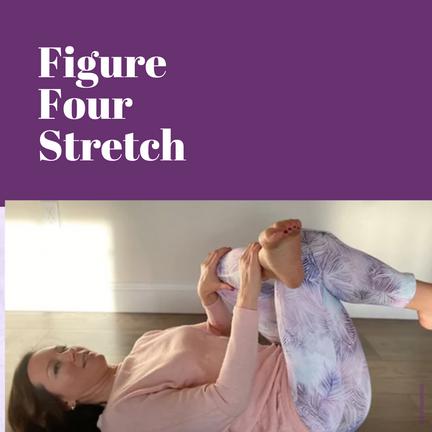
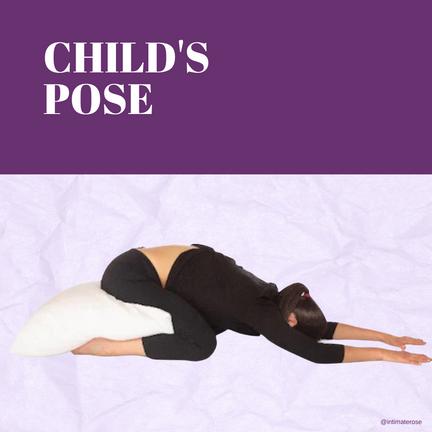
11
Adductor Stretch:
The adductor muscles are a group of muscles on the inner thigh. They attach onto the inner aspect of the pelvic bone on each side. These muscles are commonly tight in people who experience pelvic pain and vulva or vaginal pain, and those with weak pelvic floor muscles.
To do the adductor stretch, lunge to the left by bending the left knee and keeping the right leg straight. Press your hips back as if you were sitting in a chair and do not allow your left knee to press forward beyond the left foot.

12
Hamstring Stretch: The hamstring muscles are the group of muscles in the back side of the thigh. They bend the knee and extend the hip. They tend to be tight in most people that sit for prolonged periods.

The hamstrings attach to the bony part of the pelvis that you sit upon. Because of this attachment point, when they are tight, they can create tension on the low back, and can place a strain on the pelvis.
Diligence in stretching the hamstrings is a helpful for many musculoskeletal issues. To do this stretch, prop one foot up onto a stool or chair with the knee straight.
Hinge forward at the hips to lean over the stretching leg and keep the spine straight. Hold this position for 30 seconds and repeat on each leg for 3 sets.
13
Lubricants
Women may experience vaginal dryness for many reasons, over and beyond hormonal changes and PCOS, and it is nothing to be ashamed about!
Lubricants are a great option to find relief, and below we will discuss two main types:
Vulvar Balm:
Balm is meant to be used externally on the vulva on a daily basis much like you would a body lotion. It's perfect for soothing itching or painful labia and vulva, but can also help set the mood! It's a way to maintain daily moisture of the vulva, and is absorbed into the skin to help maintain healthy tissue.
When choosing a vulvar balm or vaginal moisturizer make sure the product is organic, natural, clinician developed, and free of chemicals, parabens, phthalates, and gluten.
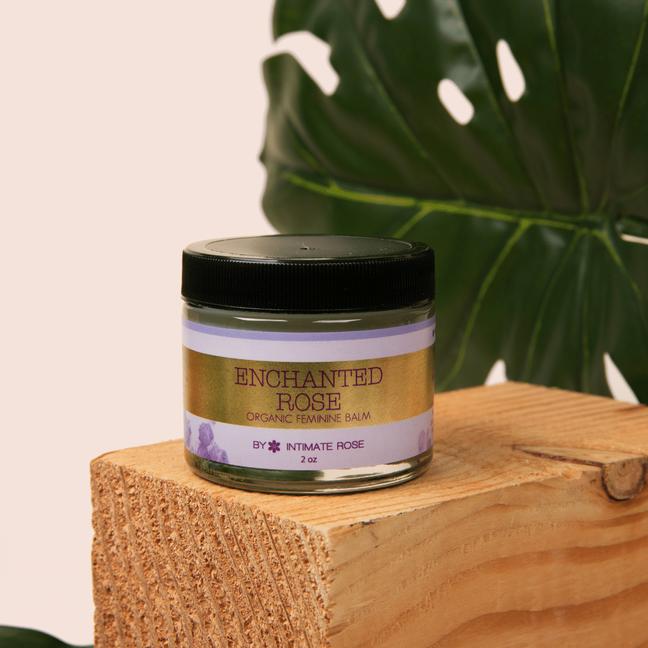
14
Water-based Lube:
For all women with mild to extreme vaginal dryness, water-based personal lubricants are incredibly effective at relieving discomfort and pain during intercourse. Water-based lubricants can be used safely alongside condoms and are known to improve sex by decreasing friction and making sex more pleasurable.
When choosing a lubricant it's important to choose a safe, water-based, toxinfree, FDA-approved product that is as close to the vagina's natural PH as possible. Oil-based substances like baby oil and petroleum jelly should be avoided as they can disrupt the natural PH of a woman’s vagina, increasing the chances of a bacterial infection.



DR. TALKS EXCLUSIVE OFFER
Use code PCOSLUBE and get a free bottle of lube with a purchase of $50 or more.
Excludes already discounted bundles
Can’t be combined with any other offer
8 165

CHANGING UP THE POSITION
Another option to try if sex is painful? Simply changing up the angles! Try different sexual positions that promote pelvic floor relaxation and comfort. This will vary based on you and your partner’s anatomy. If painful penetration is an issue, try some of these positions:
Spoon Sex: In the spoon position, penetration is often less deep. You can angle your pelvis to find a position that is comfortable.
You on Top: this allows you to control the rate and depth of penetration. Find a depth and rhythm that is comfortable.
Also, it may be helpful to speak with a sex therapist for additional insight!
16
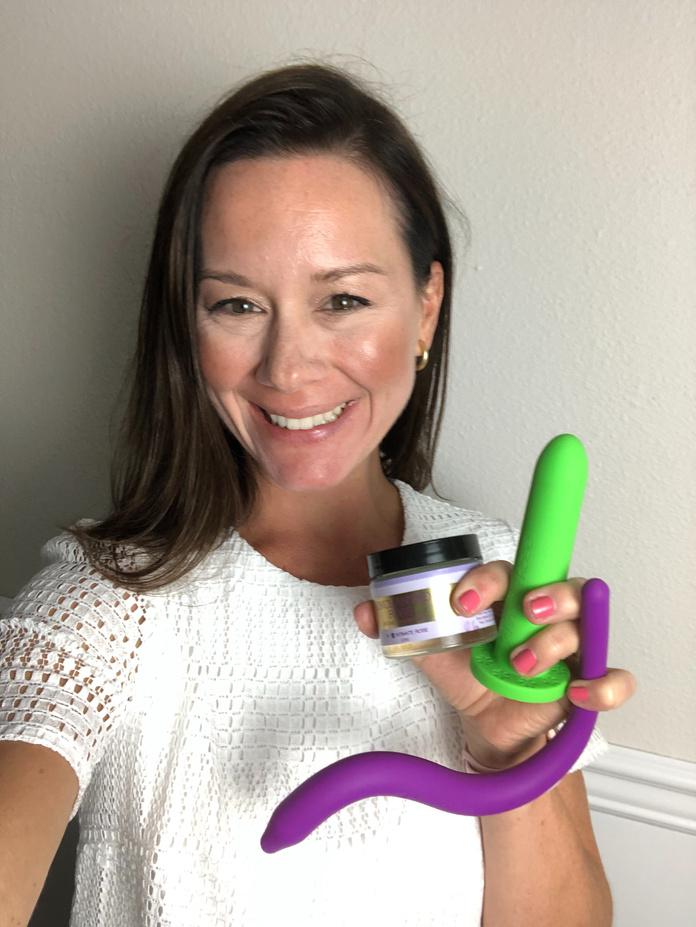
PELVIC WANDS &
DILATORS
Yes yes, we know they can look a little intimidating, but we promise they are truly game-changers when it comes to pelvic pain!
Vaginal dilators and/or pelvic wands are helpful tools that can help desensitize vaginal tissues, relax muscles, and address any scar tissue in the vaginal area. These tools allow you to work on your own time as well to progress faster between therapy sessions.
Often these resoucres are covered by your Health Savings Account (HSA). As you are shopping, be sure to look for important quality assurances, such as patented design by a physcial therapist, medical grade silicone, and/or FDA clearance.
Below we cover a few of the differences between the wands and dilators, but often they work best together! Your pelvic floor therapist can help determine what is best for you.
17
VAGINAL DILATORS
Dilators are best to treat restriction at the vaginal opening, and difficulty with any form of penetration such as from pelvic exams, tampons, or sex. Dilators are often ideal for those with vaginismus, scar tissue, or hypertonic muscles.
PELVIC WANDS
Pelvic wands are often used superficially for perineal massage, introitus stretching, and to reach deeper pelvic floor muscles. They are a great option for anyone suffering from Endometriosis and/or Interstitial cystitis pain, tailbone pain, hypertonic muscles, or deep dyspareunia.


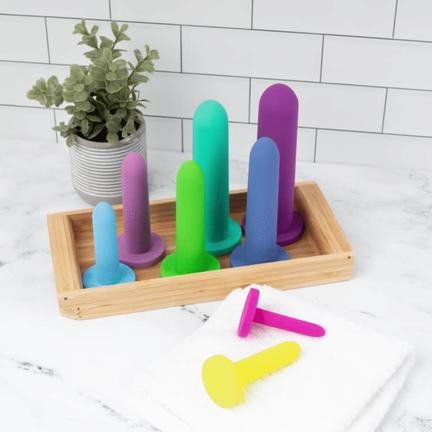
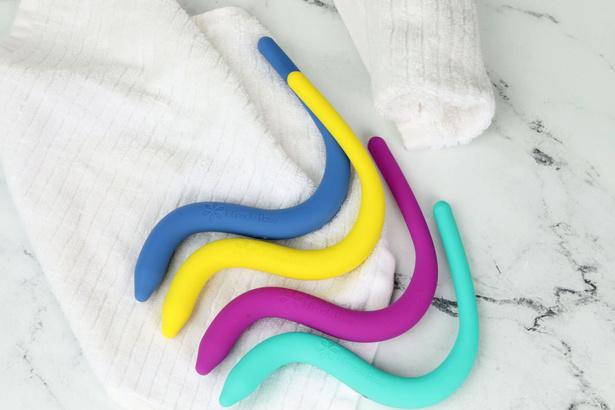
DR. TALKS EXCLUSIVE OFFER
Use code PCOSLUBE and get a free bottle of lube with a purchase of $50 or more.
Excludes already discounted bundles
Can’t be combined with any other offer
8 168

CONCLUSION
PCOS can indeed affect the pelvic floor, leading to discomfort and pain. However, with the help of pelvic floor physical therapy and the strategies mentioned in this guide, you can find relief and improve your overall pelvic health.
Don't hesitate to seek professional guidance to manage and alleviate PCOS-related pelvic pain. Remember that you are not alone, that there's hope and help for a more comfortable and healthier you!
19

Relieve pain. Restore strength. Reclaim pelvic health.
At Intimate Rose, we empower individuals to conquer sensitive health challenges with effective solutions and unwavering support. From bladder leaks to painful intimacy, our range of award-winning products--including vaginal dilators, Kegel weights, and a range of women’s supplements--has been crafted under the guidance of Dr. Amanda Olson, who understands these issues personally.
We offer more than products; we're a lifeline with private support groups, guides, and tutorials, aiming to reduce isolation in your pelvic health journey. Let us be your steadfast partner in your journey toward wellness, confidence, and comfort.
Join our community!
IntimateRose.com
Dr. Amanda Olson, DPT, PRPC President and Chief Clinical Officer

intimaterose
@




 Dr. Amanda Olson, DPT, PRPC President & Chief Clinical Officer
Intimate Rose
Dr. Amanda Olson, DPT, PRPC President & Chief Clinical Officer
Intimate Rose

























